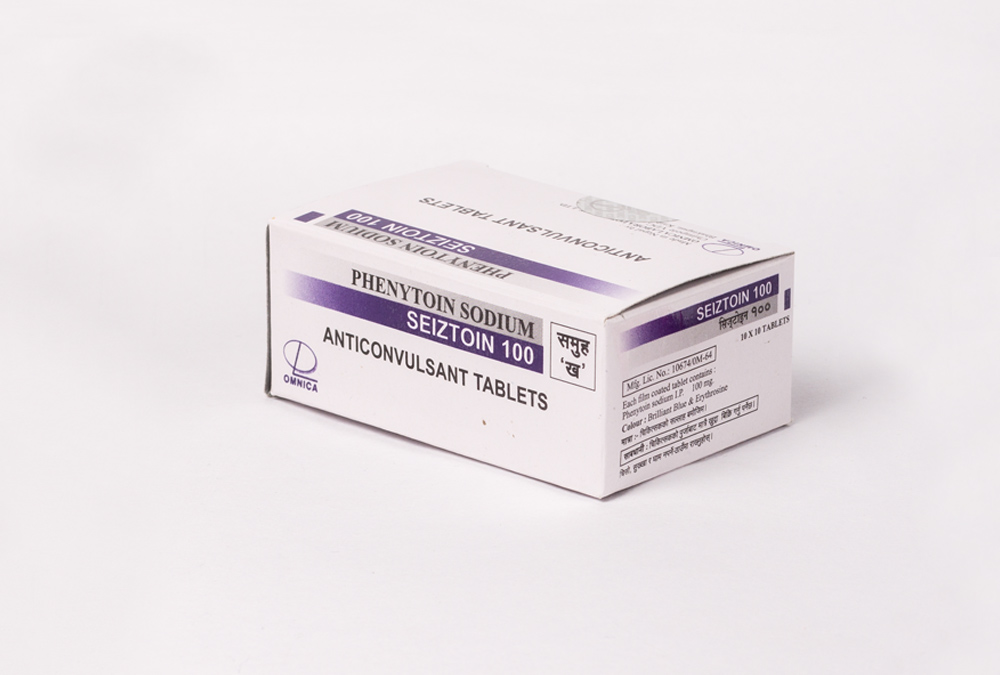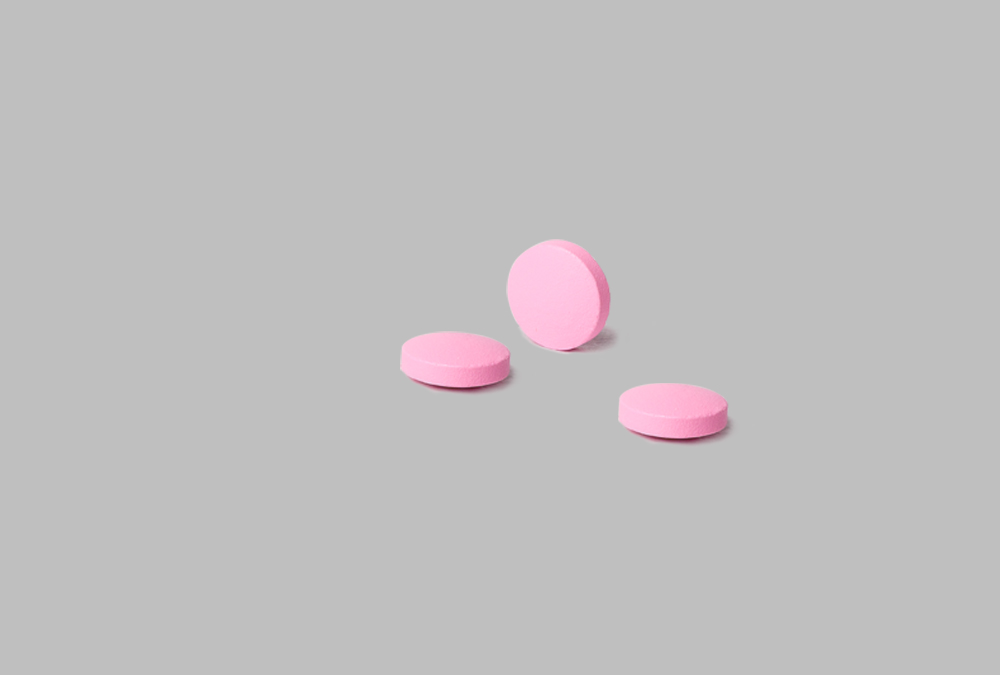Brand Name : SEIZTOIN
Generic Name : Phenytoin
Preparation : 100 mg Tablet
Pharmacological Category : Anticonvulsant (Hydantoin)
Mechanism of Action (MOA)
The primary site of action of SEIZTOIN (Phenytoin) appears to be the motor cortex, where SEIZTOIN acts on sodium channels on the neuronal cell membrane limiting the spread of seizure activity and reducing seizure propagation. Possibly by promoting sodium efflux from neurons, SEIZTOIN tends to stabilize the threshold against hyperexcitability caused by excessive stimulation or environmental changes capable of reducing membrane sodium gradient. This includes the reduction of post-tetanic potentiation at synapses. Loss of post-tetanic potentiation prevents cortical seizure foci from detonating adjacent cortical areas.
Pharmacokinetics
- Absorption : Slowly but almost completely absorbed from the gastrointestinal tract
- Onset of Action : 1 week
- Distribution : Widely distributed throughout the body
- Protein Binding : About 90%
- Metabolism : Liver
- Mean Plasma Half-life : 22 hours
- Excretion : Urine
Indications and Dosage
Partial and Generalized Tonic-Clonic Seizure :
Initially : SEIZTOIN 3 to 4 mg per kg daily or SEIZTOIN 150 to 300 mg daily single dose or in divided doses; if necessary progressively increased with care to SEIZTOIN 600 mg daily. The suggested minimum interval between increments is from about 7 to 10 days.
Maintenance dose : SEIZTOIN 200 to 500 mg daily
Status Epilepticus :
Maintenance dose : One tablet of SEIZTOIN 100 mg every 6 to 8 hours
Side Effects
COMMON : Mild hypersensitivity with skin rashes often morbiliform, sometimes accompanied by fever
OFTEN REPORTED : Headache, dizziness, tremor, transient nervousness, insomnia, nausea, vomiting, constipation, tenderness and hyperplasia of gum
OTHERS : Acne, hirsutism, coarsening of the facial features, nystagmus, diplopia, slurred speech, ataxia, mental confusion, dyskinesias, exacerbation of seizure frequency
RARE : Lupus erythematosus, erythema multiforme, Stevens-Johnson syndrome, toxic epidermal necrolysis, eosinophilia, lymphadenopathy, hepatitis, polyarteritis nodosa, aplastic anaemia, leucopenia, thrombocytopenia, agranulocytosis
OVERDOSAGE: Hypotension, coma, respiratory depression
Precautions
- Caution in patients with impaired liver function and diabetes.
- Seek medical attention if symptoms such as fever, sore throat, rash, mouth ulcers, bruising or bleeding develop.
- Should be stopped if leucopenia develops.
- Can be reintroduced cautiously in case of mild rashes but should be stopped immediately and permanently if the rash recurs.
- Care is required during withdrawing therapy.
- Phenytoin may interfere with some tests of thyroid function.
Contraindications
Hypersensitivity to phenytoin or other hydantoins, sinus bradycardia, heart block, sinoartrial block, second and third degree A-V block, Adams-Stokes syndrome, pregnancy, lactation, co-administration with delavirdine and other non-nucleoside reverse transcriptase inhibitors (NNRTIs)
Drug Interactions
- Drugs, which may increase phenytoin serum levels include acute alcohol intake, amiodarone, anti-epileptic agents (ethosuximide, felbamate, oxcarbazepine, methsuximide, topiramate), azoles (fluconazole, ketoconazole, itraconazole, miconazole, voriconazole), capecitabine, chloramphenicol, chlordiazepoxide, diazepam, disulfiram, estrogens, fluorouracil, fluoxetine, fluvastatin, fluvoxamine, H2-antagonists, halothane, isoniazid, methylphenidate, omeprazole, phenothiazines, salicylates, sertraline, succinimides, sulfonamides, ticlopidine, tolbutamide, trazodone, and warfarin.
- Drugs, which may decrease phenytoin levels, include anticancer drugs in combination (bleomycin, carboplatin, cisplatin, doxorubicin, methotrexate), carbamazepine, chronic alcohol abuse, diazepam, diazoxide, folic acid, fosamprenavir, nelfinavir, reserpine, rifampin, ritonavir, St. John’s wort, sucralfate, theophylline and vigabatrin.
- Supplements or antacids containing calcium carbonate, aluminium hydroxide, and magnesium hydroxide decrease the phenytoin levels by affecting the absorption when both drugs are taken at the same time.
- Drugs that may either increase or decrease phenytoin serum levels include phenobarbital, sodium valproate and valproic acid.
- Drugs whose efficacy is impaired by phenytoin include azoles (fluconazole, ketoconazole, itraconazole, voriconazole, posaconazole), corticosteroids, doxycycline, estrogens, furosemide, irinotecan, oral contraceptives, paclitaxel, paroxetine, quinidine, rifampin, sertraline, teniposide, theophylline and vitamin D.
- Increased and decreased prothrombin time / INR responses have been reported when phenytoin is coadministered with warfarin.
- Phenytoin decreases plasma concentrations of active metabolites of albendazole, certain HIV antivirals (efavirenz, lopinavir, indinavir, nelfinavir, ritonavir, saquinavir), anti-epileptic agents (carbamazepine, felbamate, lamotrigine, topiramate, oxcarbazepine, quetiapine), atorvastatin, chlorpropamide, clozapine, cyclosporine, digoxin, fluvastatin, folic acid, methadone, mexiletine, nifedipine, nimodipine, nisoldipine, praziquantel, simvastatin and verapamil.
- Phenytoin when given with fosamprenavir alone may decrease the concentration of amprenavir, the active metabolite. Phenytoin when given with the combination of fosamprenavir and ritonavir may increase the concentration of amprenavir.
- Resistance to the neuromuscular blocking action of the non-depolarizing neuromuscular blocking agents pancuronium, vecuronium, rocuronium, and cisatracurium has occurred in patients chronically administered phenytoin.
Pregnancy Category : D
Presentation
SEIZTOIN 100 mg: A box of 10 blisters, each blister of 10 tablets



